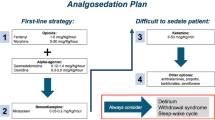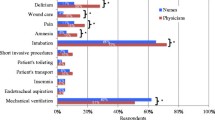Abstract
Objective
This study carried out the first patient-oriented survey on the practice of analgesia and sedation in German intensive care units, examining whether the goals of early spontaneous breathing and awake, cooperative patients are achieved.
Design
A postal survey was sent to 261 hospitals in Germany. Each hospital received three patient-oriented forms with questions regarding current agents and techniques for analgesia and sedation of a specific patient. Responses were obtained from 220 (84%) hospitals which returned 305 questionnaires.
Results
Patients' Ramsay sedation scale was significantly higher in all phases of analgesia and sedation, indicating that the patients were more deeply sedated than currently intended by the therapist. Propofol was used for most of the patients during short-term sedation (57%) and during weaning (48%). The preferred agent for sedation longer than 72 h was midazolam (66%).
Conclusion
The choice of agents and techniques for analgesia and sedation in the intensive care unit thus follows the German guidelines. The fact that the patients were more deeply sedated than intended by the therapist in all phases of sedation may be due to the low use of sedation scales and clinical practice guidelines or to the lack of training in using these techniques.


Similar content being viewed by others
References
Koepke JP (1989) Effect of environmental stress on neural control of renal function. Miner Electrolyte MeTable 15:83–87
Bonica JJ (1987) Importance of effective pain control. Acta Anaesthesiol Scand Suppl 85:1–16
Lewis KS, Whipple JK, Michael KA, Quebbeman EJ (1994) Effect of analgesic treatment on the physiological consequences of acute pain. Am J Hosp Pharm 51:1539–1554
Tonner PH, Weiler N, Paris A, Scholz J (2003) Sedation and analgesia in the intensive care unit. Curr Opin Anaesthesiol 16:113–121
Schaffrath E, Kuhlen R, Tonner PH (2004) [Analgesia and sedation in intensive care medicine.]. Anaesthesist 53:1111–1130
Putensen C, Zech S, Wrigge H, Zinserling J, Stuber F, Von Spiegel T, Mutz N (2001) Long-term effects of spontaneous breathing during ventilatory support in patients with acute lung injury. Am J Respir Crit Care Med 164:43–49
Tung A, Rosenthal M (1995) Patients requiring sedation. Crit Care Clin 11:791–802
Martin J, Bäsell K, Bürkle H, Hommel J, Huth G, Kessler P, Kretz FJ, Putensen C, Quintel M, Tonner P et al. (2005) Analgesie und Sedierung in der Intensivmedizin-S2-Leitlinien der Deutschen Gesellschaft für Anästhesiologie und Intensivmedizin. Anasth Intensivmed 46:1–20
Merriman HM (1981) The techniques used to sedate ventilated patients. A survey of methods used in 34 ICUs in Great Britain. Intensive Care Med 7:217–224
Gast PH, Fischer A, Sear JW (1984) Intensive care sedation now. Lancet 8407:863–864
Miller-Jones CMH, Williams JH (1980) Sedation for ventilation. A retrospective study to ventilated patients. Anaesthesia 35:1104–1106
Burns AM, Shelly MP, Park GR (1992) The use of sedative agents in critically ill patients. Drugs 43:507–515
Kollef MH, Levy NT, Ahrens TS, Schaiff R, Prentice D, Sherman G (1998) The use of continuous i.v. sedation is associated with prolongation of mechanical ventilation. Chest 114:541–548
Durbin CG Jr (1994) Sedation in the critically ill patient. New Horiz 2:64–74
Martin J, Parsch A, Franck M, Wernecke KD, Fischer M, Spies C (2005) Practice of sedation and analgesia in German intensive care units: results of a national survey. Crit Care 9:R117–R123
Soliman H, Melot C, Vincent J (2001) Sedative and analgesic practice in the intensive care unit: the results of a European survey. Br J Anaesth 87:186–192
Jacobi J, Fraser GL, Coursin DB, Riker RR, Fontaine D, Wittbrodt ET, Chalfin DB, Masica MF, Bjerke HS, Coplin WM et al. (2002) Clinical practice guidelines for the sustained use of sedatives and analgesics in the critically ill adult. Crit Care Med 30:119–141
Ramsay MA, Savege TM, Simpson BR, Goodwin R (1974) Controlled sedation with alphaxalone-alphadolone. BMJ 2:656–659
Vincent JL, Moreno R, Takala J, Willatts S, De Mendonca A, Bruining H, Reinhart CK, Suter PM, Thijs LG (1996) The SOFA (Sepsis-related Organ Failure Assessment) score to describe organ dysfunction/failure. On behalf of the Working Group on Sepsis-Related Problems of the European Society of Intensive Care Medicine. Intensive Care Med 22:707–710
Kress JP, Pohlman AS, O' Connor M, Hall JB (2000) Daily interruption of sedative infusions in critically ill patients undergoing mechanical ventilation. N Engl J Med 342:1471–1477
Doi M, Morita K, Mantzaridis H, Sato S, Kenny GN (2005) Prediction of responses to various stimuli during sedation: a comparison of three EEG variables. Intensive Care Med 31:41–47
Andrews P, Azoulay E, Antonelli M, Brochard L, Brun-Buisson C, Dobb G, Fagon JY, Gerlach H, Groeneveld J, Mancebo J et al. (2006) Year in review in intensive care medicine, 2005. II. Infection and sepsis, ventilator-associated pneumonia, ethics, haematology and haemostasis, ICU organisation and scoring, brain injury. Intensive Care Med 32:380–390
Walsh TS, Ramsay P, Kinnunen R (2004) Monitoring sedation in the intensive care unit: can “black boxes” help us? Intensive Care Med 30:1511–1513
Otter H, Martin J, Bäsell K, von Heymann C, Hein O, Böllert P, Jänsch P, Behnisch I, Wernecke K-D, Konertz W et al. (2005) Validity and reliability of the DDS for severity of delirium in the ICU. Neurocrit Care 2:150–158
Ely EW, Shintani A, Truman B, Speroff T, Gordon SM, Harrell FE Jr, Inouye SK, Bernard GR, Dittus RS (2004) Delirium as a predictor of mortality in mechanically ventilated patients in the intensive care unit. JAMA 291:1753–1762
Blum RH, Raemer DB, Carroll JS, Sunder N, Felstein DM, Cooper JB (2004) Crisis resource management training for an anaesthesia faculty: a new approach to continuing education. Med Educ 38:45–55
Bion JF, Ledingham IM (1987) Sedation in intensive care-a postal survey. Intensive Care Med 13:215–216
MacLaren R, Plamondon JM, Ramsay KB, Rocker GM, Patrick WD, Hall RI (2000) A prospective evaluation of empiric versus protocol-based sedation and analgesia. Pharmacotherapy 20:662–672
Mascia MF, Koch M, Medicis JJ (2000) Pharmacoeconomic impact of rational use guidelines on the provision of analgesia, sedation, and neuromuscular blockade in critical care. Crit Care Med 28:2300–2306
Breitfeld C, Peters J, Vockel T, Lorenz C, Eikermann M (2003) Emetic effects of morphine and piritramide. Br J Anaesth 91:218–223
Murdoch S, Cohen A (2000) Intensive care sedation: a review of current British practice. Intensive Care Med 26:922–928
Brodner G, Van Aken H, Hertle L, Fobker M, Von Eckardstein A, Goeters C, Buerkle H, Harks A, Kehlet H (2001) Multimodal perioperative management-combining thoracic epidural analgesia, forced mobilization, and oral nutrition-reduces hormonal and metabolic stress and improves convalescence after major urologic surgery. Anesth Analg 92:1594–1600
Beattie WS, Badner NH, Choi P (2001) Epidural analgesia reduces postoperative myocardial infarction: a meta-analysis. Anesth Analg 93:853–858
Rodgers A, Walker N, Schug S, McKee A, Kehlet H, van Zundert A, Sage D, Futter M, Saville G, Clark T et al. (2000) Reduction of postoperative mortality and morbidity with epidural or spinal anaesthesia: results from overview of randomised trials. BMJ 321:1493
Walz M, Mollenhoff G, Muhr G (1999) Verkürzung der Weaningphase nach maschineller Beatmung durch kombinierte Gabe von Clonidin und Sufentanil. Chirurg 70:66–73
Bohrer H, Bach A, Layer M, Werning P (1990) Clonidine as a sedative adjunct in intensive care. Intensive Care Med 16:265–266
Ostermann ME, Keenan SP, Seiferling RA, Sibbald WJ (2000) Sedation in the intensive care unit: a systematic review. JAMA 283:1451–1459
Zielmann S, Grote R (1995) Auswirkungen der Langzeitsedierung auf die intestinale Funktion. Anaesthesist 44 Suppl 3:549–558
Rumbak MJ, Newton M, Truncale T, Schwartz SW, Adams JW, Hazard PB (2004) A prospective, randomized, study comparing early percutaneous dilational tracheotomy to prolonged translaryngeal intubation (delayed tracheotomy) in critically ill medical patients. Crit Care Med 32:1689–1694
Hack G, Götz E, Sorgatz H, van Eimeren W, Wulff A (2000) Umfrage zur Situation der Anästhesiologie in Deutschland. Anasth Intensivmed 41:535–541
Author information
Authors and Affiliations
Corresponding author
Additional information
J.M. has been employed by GlaxoSmithKline and B.Braun to present educational talks on therapy for analgesia and sedation and economics. The authors declare that they have no competing or financial interests.
Electronic supplementary material
Rights and permissions
About this article
Cite this article
Martin, J., Franck, M., Fischer, M. et al. Sedation and analgesia in German intensive care units: how is it done in reality? Results of a patient-based survey of analgesia and sedation. Intensive Care Med 32, 1137–1142 (2006). https://doi.org/10.1007/s00134-006-0214-6
Received:
Accepted:
Published:
Issue Date:
DOI: https://doi.org/10.1007/s00134-006-0214-6




